
Welcome to Haviland Cottage
Welcome to Haviland Cottage
A luxury holiday cottage nestled in pretty Bonchurch village, near Ventnor, Isle of Wight

Welcome to Haviland Cottage
A luxury holiday cottage nestled in pretty Bonchurch village, near Ventnor, Isle of Wight
In 1849, the author Charles Dickens moved to Bonchurch, Isle of Wight for a long summer with is family. During this time, he enjoyed walking around Bonchurch village, Ventnor and the surrounding areas. He also got to know many people in the local community which influenced his writing. In fact, a few of these local characters found their way into some of his most celebrated literary works which have become some of the world’s favourite books David Copperfield (published 1850) and Great Expectations (published 1860).
We have researched the local history and verified details with plenty of help from Ventnor Heritage Centre, Bonchurch Community Association, Members of the Charles Dickens Fellowship, and lots more.
From the research we can reveal details of local characters and who they are in his works.
We have also curated a walk of key locations, so you can retrace the steps of Charles Dickens as you walk through Bonchurch and Ventnor. Starting at Haviland Cottage, follow the Dickens literary walks. Visit local places of interest and trace the history of characters that appear in his books. Below are some of the key characters and locations:
Dickens’s character Miss Betsy Trotwood thought Mr Dick (her relative and tenant) was the wisest man she knew, although his family thought him odd and wanted to 'put him away.' The only odd thing was his obsession with his work on his memorial from which he was constantly distracted by thoughts of King Charles’ head. He ended up making huge kites out of the spoiled paper used for the memorials, which he sometimes flew with David. Despite Mr Dick’s somewhat childlike nature he had a lot of common sense and was a staunch supporter of David Copperfield.
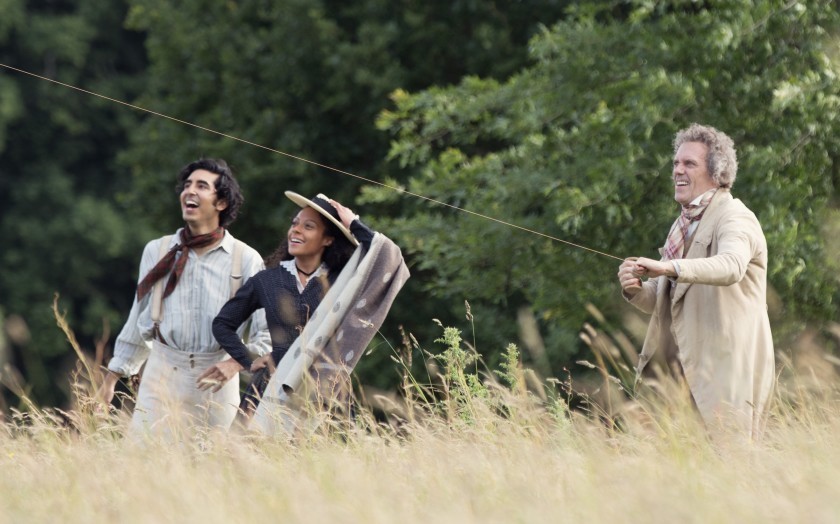
Dev Patel, Rosalind Eleazar and Hugh Laurie in the movie “The Personal History of David Copperfield.” 2017 (Dean Rogers). Hugh Laurie plays the part of Mr Dick
Miss Havisham is a fictional character in the novel Great Expectations by Charles Dickens. She is portrayed as a rich, middle-aged woman who has suffered with mental wellness problems due to being jilted at the altar when she was young. In the book she lives in her once luxurious home which is now in ruins and wears her wedding dress for the rest of her life. Miss Havisham was part villain to Pip and part fairy Godmother to her my adopted daughter Estella.
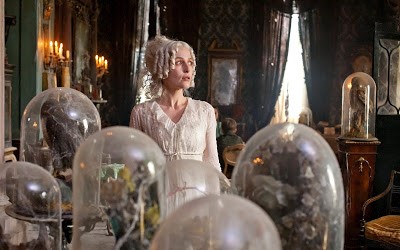
Gillian Anderson as “Miss Havisham” in Great Expectations -2011 (Directed
by Brian Kirk)
I have been researching (with the help of many collaborators) and the help of the Dickens society, the connections of past Bonchurch residents that inspired two of Charles Dickens Characters, and conclude that both “Mr Dick” from David Copperfield and “Miss Havisham” from Great Expectations are based on Bonchurch folk!
Dickens left a lifetime of letters that he wrote (more than 14,000 and counting ), which have helped researchers to pinpoint the exact location and date of his movements, from these letters we have been able to build connections with the Island and Bonchurch in particular. On 3rd September 1860 , shortly before writing Great Expectations he made a bonfire at Gad's Hill near Rochester , Kent ( the house that he lived in for the last thirteen years of his life) of all the letters he had received from people. It's a shame he didn't keep them as they would have contained a lot of useful information. More important are the letters he wrote to other people, most people who received letters from him kept them.
Charles Dickens first visited the island with his wife Kate in September 1838 [7] staying at the Groves Needles Hotel Alum Bay, between 3rd & 8th September – writing a humorous letter to the proprietor James Groves (1) , before moving on to Ventnor and staying at The Ventnor Hotel ( the predecessor name for the Royal Hotel ) from 8th -10th September. The Royal was built in 1831 and run by John Fisher. In 1844 the hotel was kept by a Mr Keatly and her Majesty Queen Victoria took refreshment here before visiting Steephill Castle[8].
The Groves Needles Hotel Alum Bay, was built in 1825 by James Groves of Freshwater , is now known as Alum Bay House , and converted into 6 private apartments named after famous authors such as Tennyson , Priestley and Keats ( but not Dickens !) . Charles Dickens stayed between 3rd & 8th September 1838 , writing a humorous prose to the proprietor James Groves:
" Oh Mr. Groves, If so be you approves
Of writings in rhyme Knocked off in a quick time........... "
(see reference 1 below)
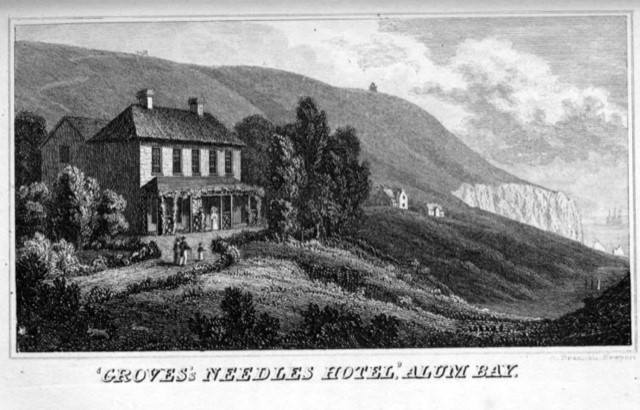
The Ventnor Family Hotel & Boarding House, Isle of Wight RCIN 701466
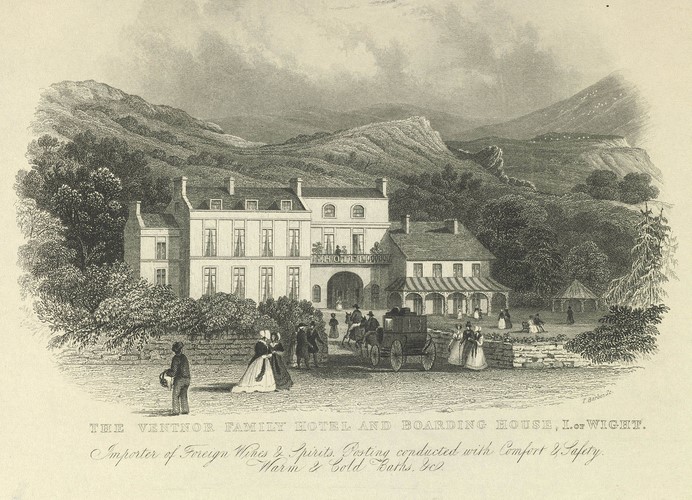
There was also a Groves Hotel in Ventnor, but it there is no clear link between the two hotels.
The small cottage (Hillside) can be seen in front of ‘Groves Hotel’ in the engraving here by T. Higham from 1824. From Ventnor & District Local History Society
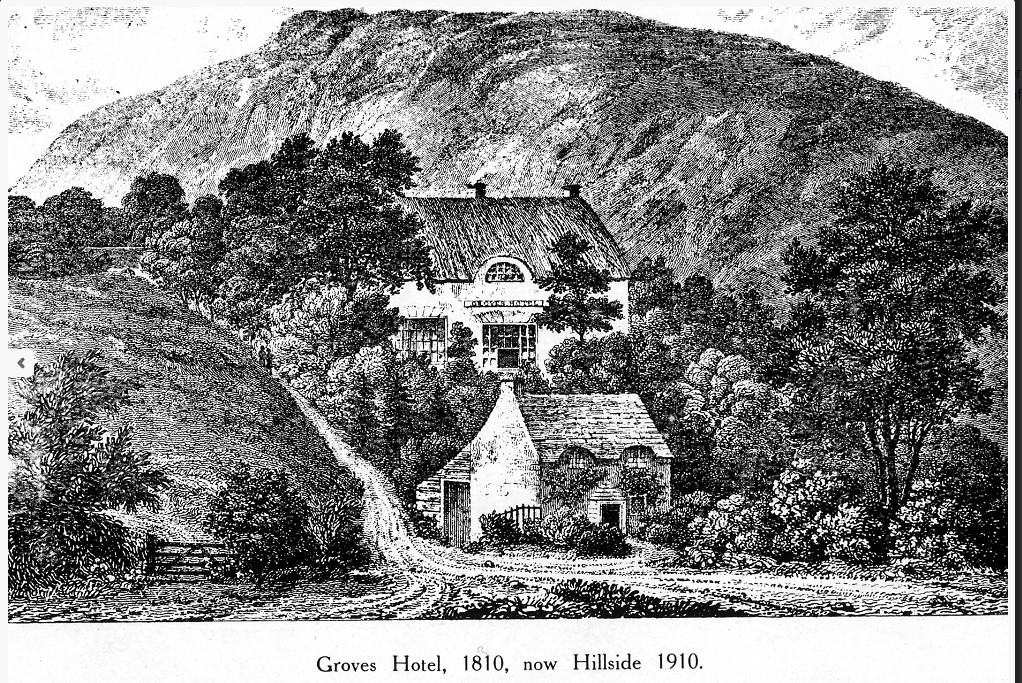
In nearby Bonchurch, a similar named property, Hill Cottage (now Hillside Cottage) was later used by Dickens close friend & illustrator John Leech, who was with Dickens in the summer of 1849.
John Leech came to fame in 1840, when Dickens commissioned him to illustrate “A Christmas Carol”. With Dickens story and Leech's illustration it changed the way the public viewed Christmas. Indeed the 2017 Film “The man who invented Christmas” starring Simon Callow as John Leech was based on this story.
John Leech became very ill whilst at Hillside Cottage with Charles Dickens caring for him (2).
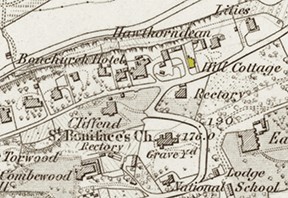
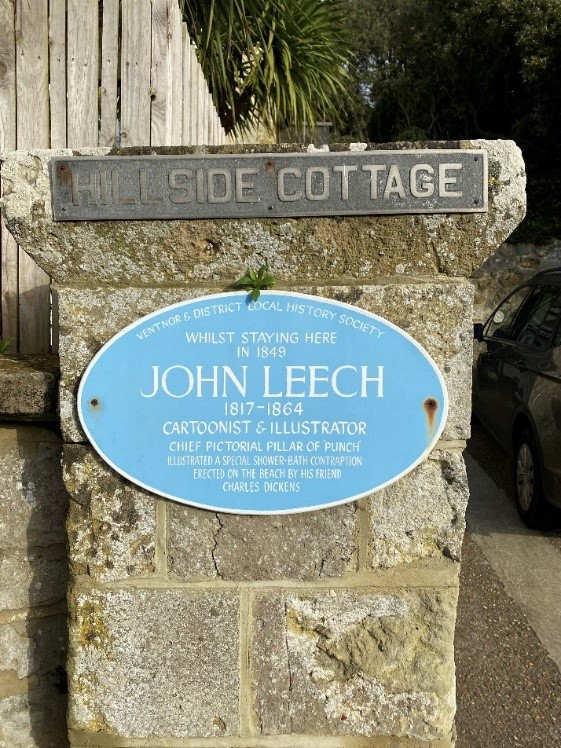
Charles Dickens’s second visit to the Isle of Wight was a deep immersion to village life when in 1849 when spent a long summer in Bonchurch village. There was a letter to his Accountants on 17th July 1849 ( see 3) , but a much more interesting letter to his wife Kate dated 16th June , but dated stamped 17th July - indicating Dickens got the month wrong ( as he sometimes did ). The letter shows his enthusiasm for the stream that ran through the property. The source of the stream is a natural spring in the grounds of Winterbourne, it drops down the cliff face to the shore, where the aptly named "Waterfall cottage" stands today. The perpetual "shower-bath' that Dickens had constructed was located behind the garage of Waterfall Cottage.
The stream still runs through the property and alongside the Old Saint Boniface church., and if you venture on our walk, you will walk over it !
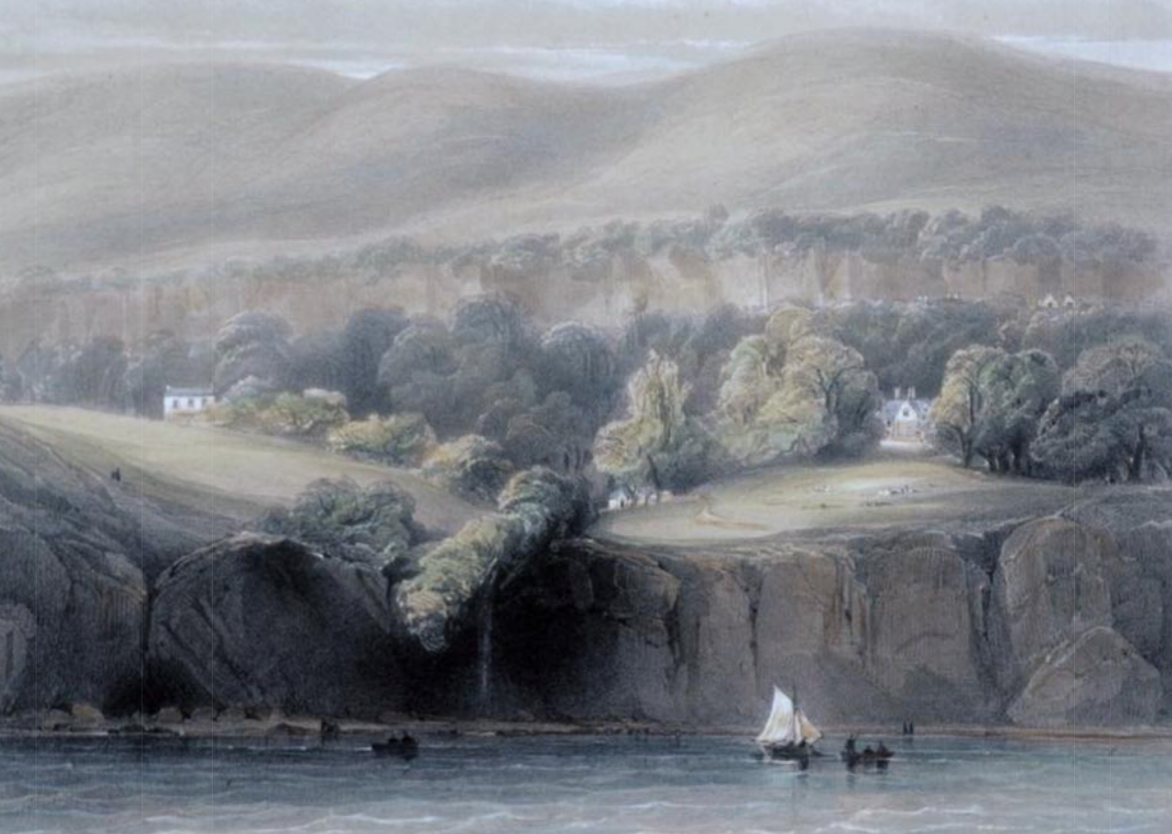
A. Robert Carrick, lithograph, 1845
Here you see the source of water for Dickens shower bath , from an 1845 painting by A. Robert Carrick. The church stands in the middle, Winterbourne is tucked in the trees and is only just visible, East Dene to the left. The cliffs are fairly intact before landslip has occurred. The waterfall would have given an impressive shower bath.
The Author, Property Developer & close friend of Dickens the Rev James White, rented his substantial property “Winterbourne Villa” to the Dickens family for their entire stay in 1849.
During his time at Winterbourne , Dickens spent lots of time with Rev James White and his wife Rosa at Woodlynch, which according to his biographer John Forster were some of Dickens's happiest hours writing "With Dickens, White was popular supremely for his eager good fellowship; and few men brought him more of what he always like to receive . But he brought nothing so good as his wife."He is excellent, but she is better" is the pithy remark of his first Bonchurch letter ; and the true affection and respect that followed is happily still bourne by his daughters" (11)
Dickens also wrote of Rev James White " White very jovial and emulous of the inimitable in respect of "gin -punch"
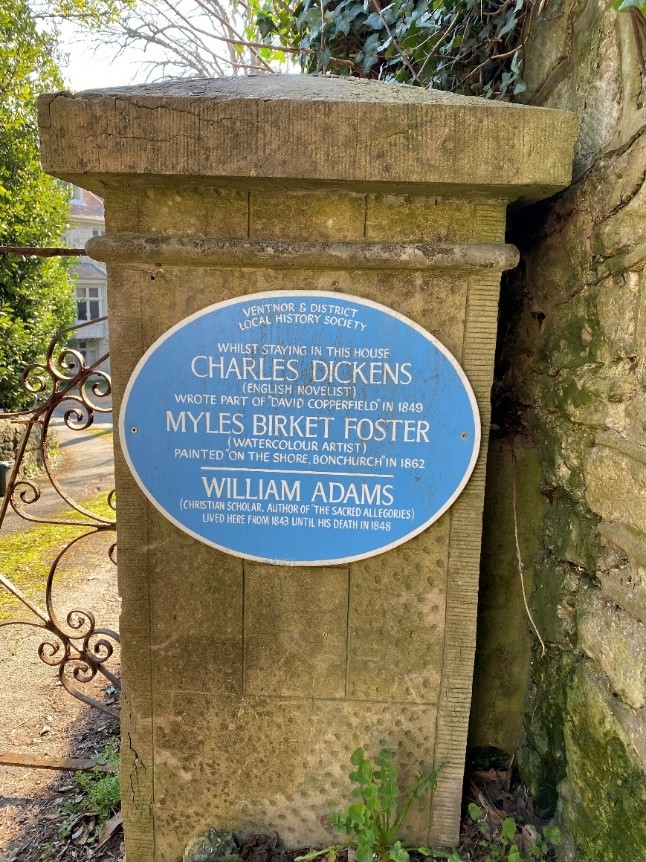
Mr Dick first appears in David Copperfield in chapter 13, the first chapter Dickens wrote when he moved into Winterbourne. We know from local sources [4] that he became acquainted with the whole of the Dick family lead by Captain Samuel Dick and visited them at “Uppermount” where they lived , but it was Charles George Dick who became a particular friend of Dickens , and the two men, who were both aged 37 at the time went for walks together most noticeably up Saint Boniface Down (the highest point on the Isle of Wight) an ideal kite flying location.
"Mr Dick" the character in "David Copperfield" was only a nickname for Betsy Trotwood's lodger at “Blunderstone Cottage.", whose real name in the story was Richard Babley. According to The Dickensian Magazine; Winter 2005 pg. 256 , Dickens had already decided on the character before he met the Dick family, but after striking up a friendship with Charles he honoured him by deciding to apply "Mr Dick" as a nickname.
Before he moved to Winterbourne, Dickens had spent a week in Broadstairs (see also Fort House now Bleak House), finishing up to Chapter 12 of David Copperfield. Mr Dick appeared in the next chapter. The timings work wonderfully.
Whilst at Winterbourne, Dickens regularly entertained many of his wide circle of literary friends including William Makepeace Thackeray, Thomas Carlyle and Alfred Tennyson.
Opposite the entrance to “Winterbourne “is “East Dene” where the 12-year-old Algernon Swinburne lived with his parents. The Dickens family regularly had “High Tea” with the Swinburne’s (4).
The young Queen Victoria had also bought Osborne House (in East Cowes) a few years earlier and moved in during 1848 because of Revolutionary scares that had recently deposed King Louis Philippe 1 of France.
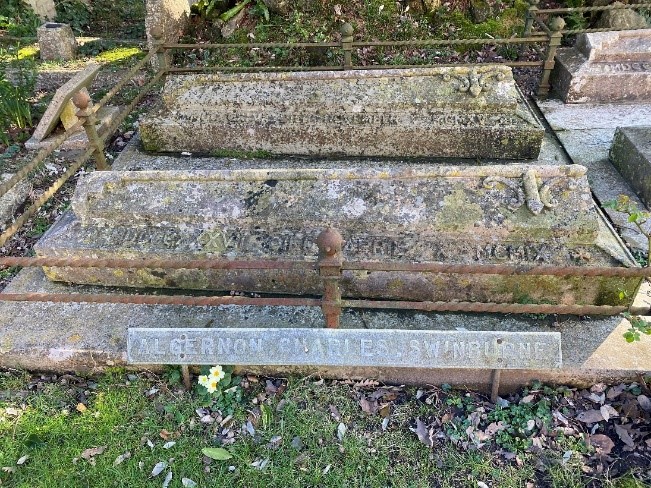
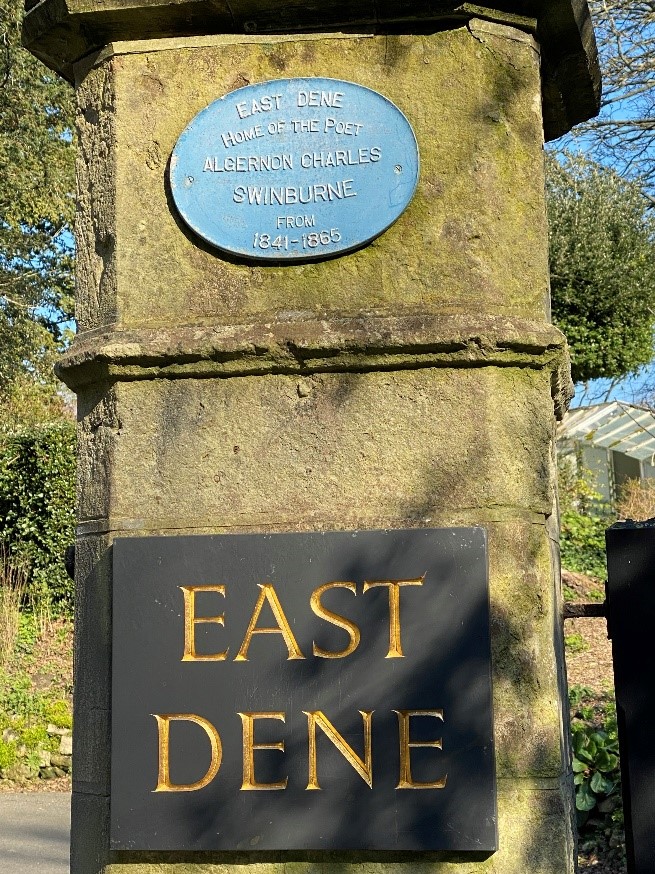
Miss Catherine Fane Haviland and her cousin Miss Margaret Blennerhasett moved together to "Ashleigh" in 1852, and had three female servants living in the house . During her ownership she had constructed a Coach House and stables in the grounds now known as “Haviland Cottage.”
Miss Haviland and Miss Blennerhasett who termed their occupation as “Gentle-women” appeared regularly on the social scene including "The Fashionable List" [9} They sold Ashleigh with the accompanying coach house in 1862.
Queen Victoria often visited Ashleigh, and the stunning entrance porch standing today is rumoured to have been built for her visits. In one visit in January 1869 , she arrived in the Royal Open Carriage with an entourage and a substantial crowd of well wishers gathered outside heartily cheering her on leaving.
Coach House built for Miss Haviland – Madeira Vale 1860 (Drawing from Haviland Cottage) then in the Grounds of "Ashleigh" next door.
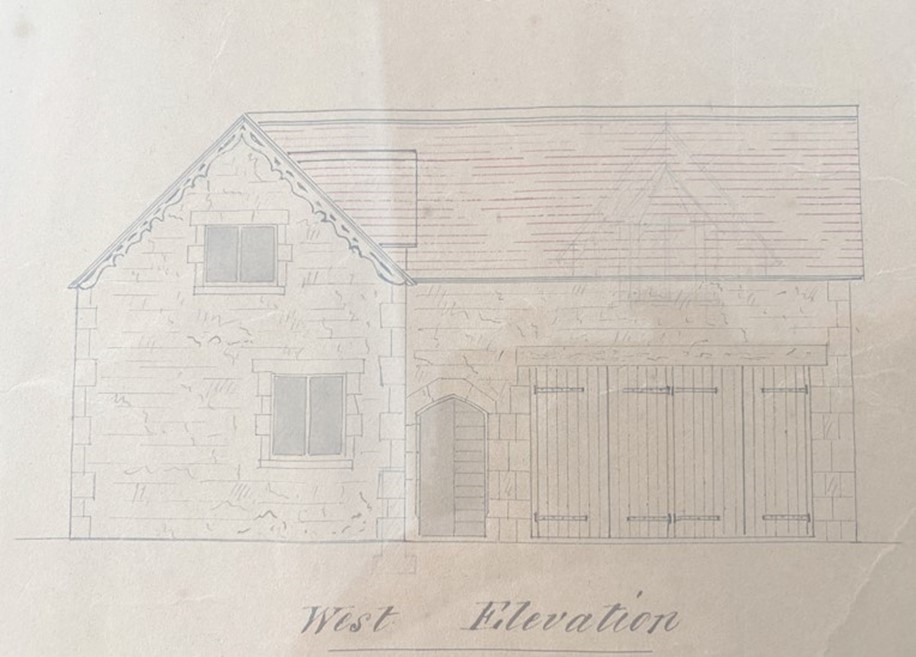
The Dick family home “Uppermount” was renamed firstly “Coombe Wood” and later “Peacock Vane” when the much-loved Joan Wolfenden along with her husband ‘Woolfie’ established the very first Country House Hotel. She was also an author and illustrator. Although the property is now known as Peacock Vane, the carved name Coombe Wood remains on the gate post.
The Dick family was led by Captian Samuel Dick RN, with one son , Charles George Dick , and three younger daughters , Ann, Mary and Margaret.
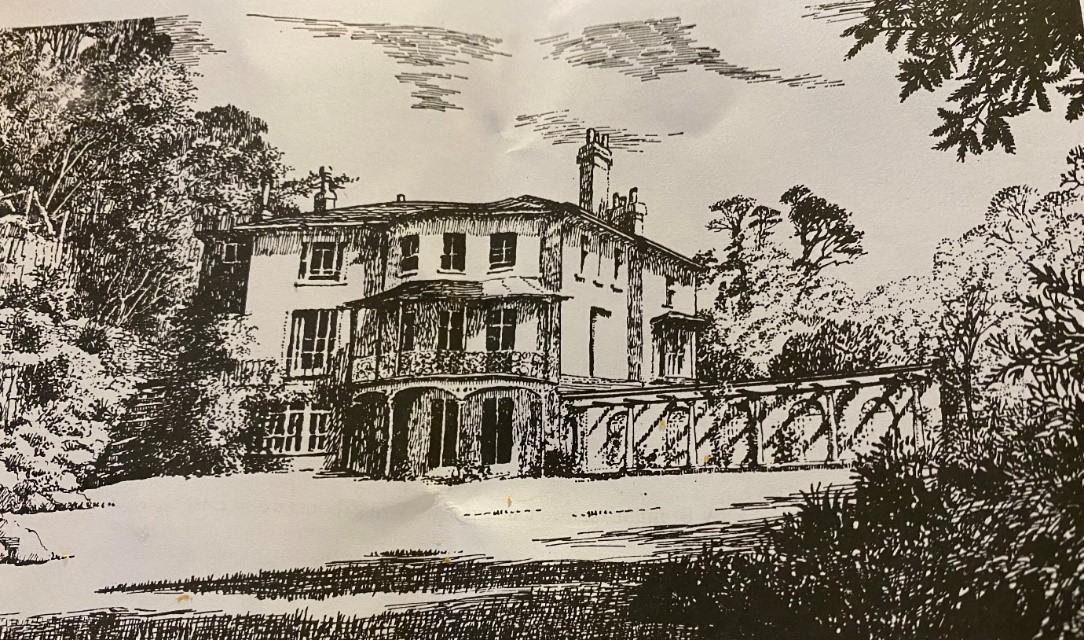
Samuel Dick passed away at Uppermount in 1856 (aged 72) but was buried at his family’s vault in Ashford Kent, his son Charles Dick married Williamena King and outlived his three sisters and died in 1888 ( aged 77) , and buried in Ventnor Cemetary.
After Samuel Dick's death in 1860, his daughter Margaret Catherine Dick was jilted on the morning of her wedding at Holy Trinity Church and left the family home to live a reclusive life in Madeira Hall.
According to the delightful book “Dickens on an Island” [5] Charles Dickens visited the Island in November/December 1860, perhaps to see his friend Rev. James White, whose daughter died earlier that year – indeed Dicken’s two daughters ( Katie & Mamie) had visited Bonchurch to give comfort earlier in the year to his dying daughter [6]. Dickens, either directly, through his friend Charles Dick , his two daughters or Rev James White, would have learned about Margaret Dick’s unfortunate aborted wedding, and the arrival of Miss Catherine Haviland into one of the grand houses in the village. It is probable that Rev James White's letters to Dickens would have been burnt in the great "letter bonfire" of that year ,as the Rev White was due to marry Margaret Dick.
It is generally considered that Margaret Dick’s failed marriage was the inspiration for Miss Havisham who was also jilted at the altar in Great Expectations. Opposite Madeira Hall there are also former stables and a coach house built in 1860 for a "Miss Haviland" and now called Haviland Cottage. Similar building(s) are mentioned as the coach house to Statis House in Great Expectations.
I am now convinced that Charles Dickens based the idea of Miss Havisham on Margaret Dick but named the character after her neighbour Catherine Haviland. The dates, location, and similarities to real life match to a tee!
Margaret Dick (Miss Havisham) died in 1878 aged 52, leaving Madeira Hall to her brother Charles George Dick in the will. She is buried in Ventnor Cemetery just 10 meters away from her Brother Charles Dick and his wife Willamena , at Ventnor Cemetery in Upper Ventnor. Miss Catherine Haviland also died aged 52 in Lausanne , Switzerland.
Photos from Alan Cartwright .

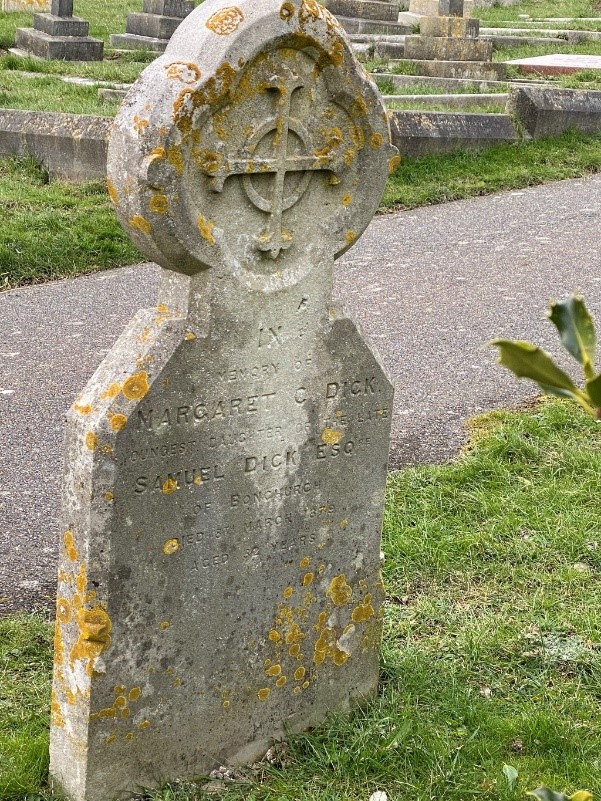
The Charles Dickens Literary Walk
The short walk is just around two hours and concentrates on the Victorian Celebrity hotspot of Bonchurch, however please be warned that it is challenging walk including the 101 steps. If you enjoyed the walk, please consider making a voluntary donation of £3 or more to the Bonchurch Community Association - which provides for the upkeep of the beautiful village, and for community events.
Please make a transfer to the BCA , Sort Code 54-10-34 , Account # 18483488 Ref Haviland
Guided Tour by Sue Lowday
If you would like to going on a guided tour around the Village , we highly recommend Sue Lowday ( one of the key contributors to this project ) and an expert on Dickens and Bonchurch.
For more information and to book your tour please visit Dickens Walking Tour | Dickens Walks
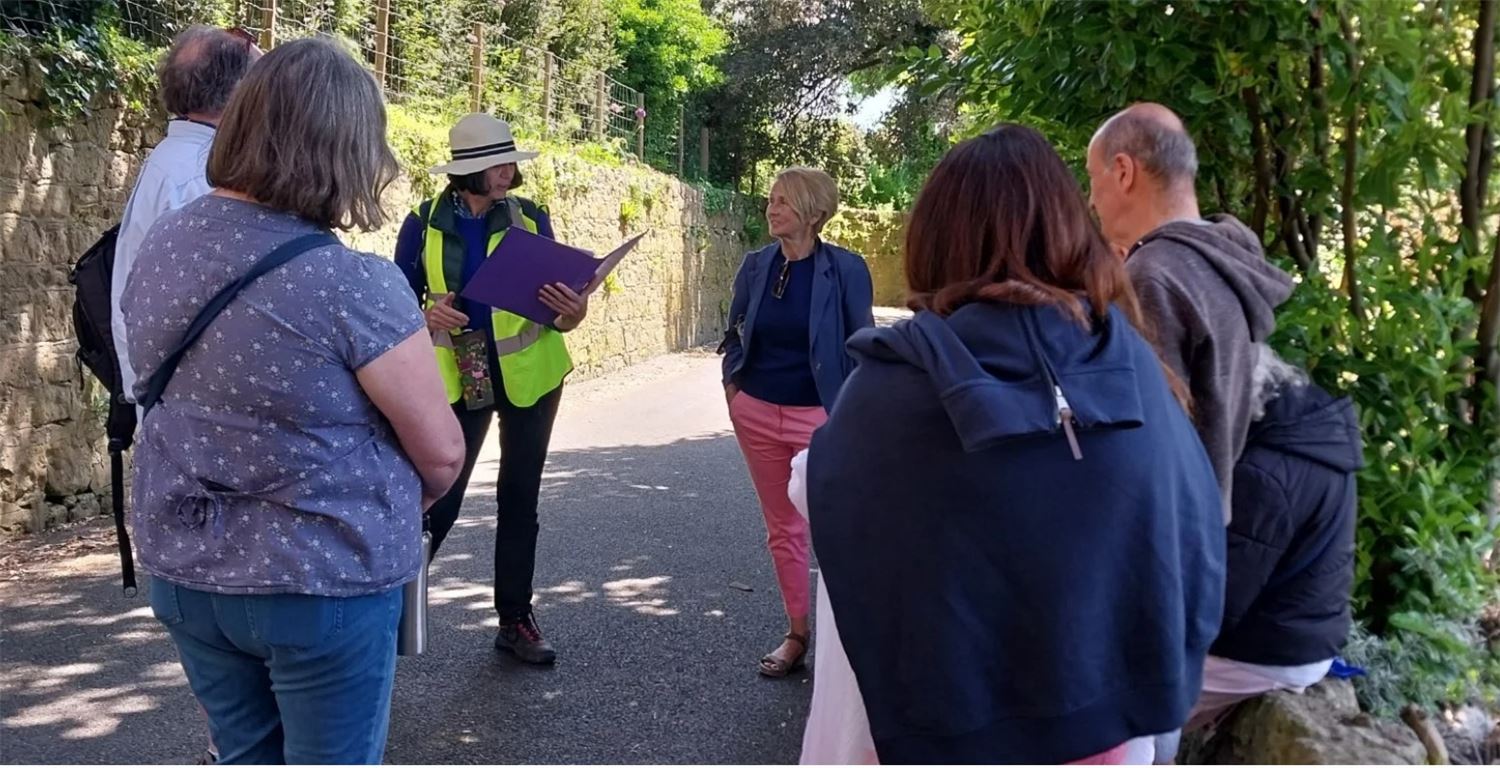
I’d particularly like to thank:
Les Matravers -Historian
Sue Lowday (Bonchurch Community Association)
Geoff Christopher & Professor Tony Pointon (Members of the Dickens Fellowship)
Sean Ridgeway – The Dickens Society, who have enthusiastically helped me with several “gems” of information.
John Matthews- Former Isle of Wight Coroner and local historian who helped me with "Mr Peggotty" as a Fisherman at Luccombe Chine & Beach.
Wayne Giddes: for prompting me to investigate the history of Haviland Cottage
Lin Arnold– Local Playwright and long-time advocate that Margaret Dick was the basis for Miss Havisham
Rev Hugh Wright – Vicar of Saint Boniface Parish Church, whose drawings are reproduced with their permissions.
Caroline Dudley who provided further input on James Groves of Freshwater,
Vic King – Historian, Lesley Telford: Trustee, Ventnor Heritage Centre, Giovan Hayer ( Twinkl) & Pamela Parker – Island Photographer.
Alan Cartwright
www.havilandcottage.com
First Published : 21st March 2021
Updated: 27th September 2023
Post Script
We hosted a Garden Party on 23rd June 2021 , to thank the many that helped bring to life the story of Miss Havisham and Mr Dick . Guest of honour was Ian Dickens , President of the Dickens Fellowship and the Great, Great Grandson of Charles Dickens , and Tom Suffolk and Geoff Christopher from the Birthplace Branch of the Dickens Fellowship, who delighted our guests with readings from David Copperfield and Great Expectations.
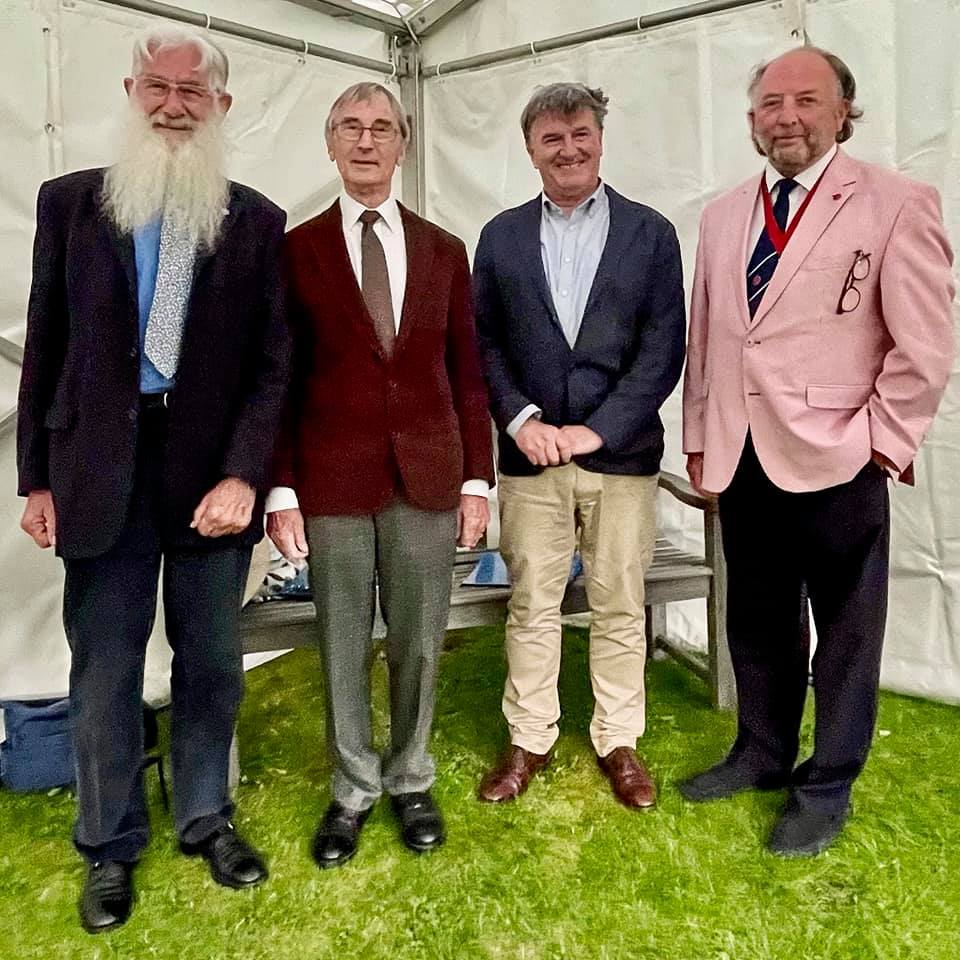
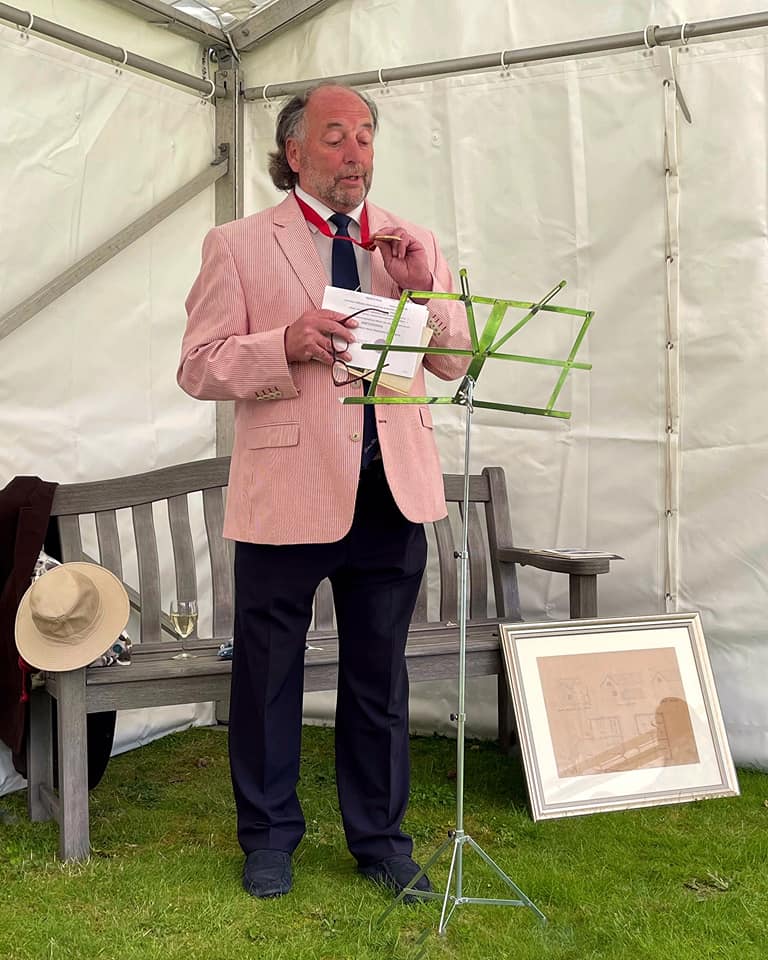
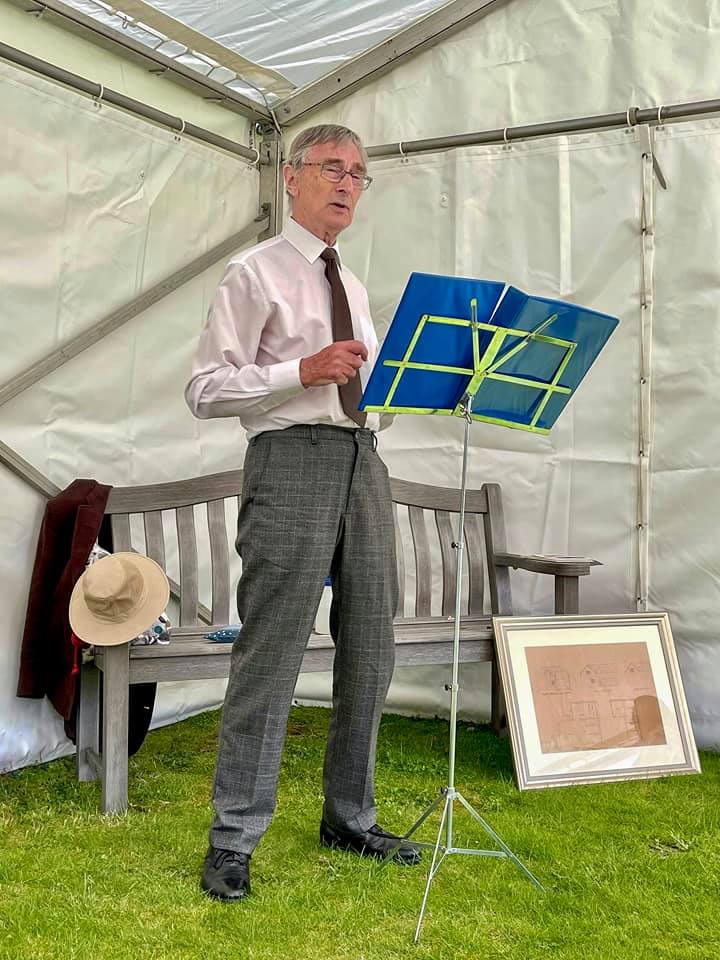
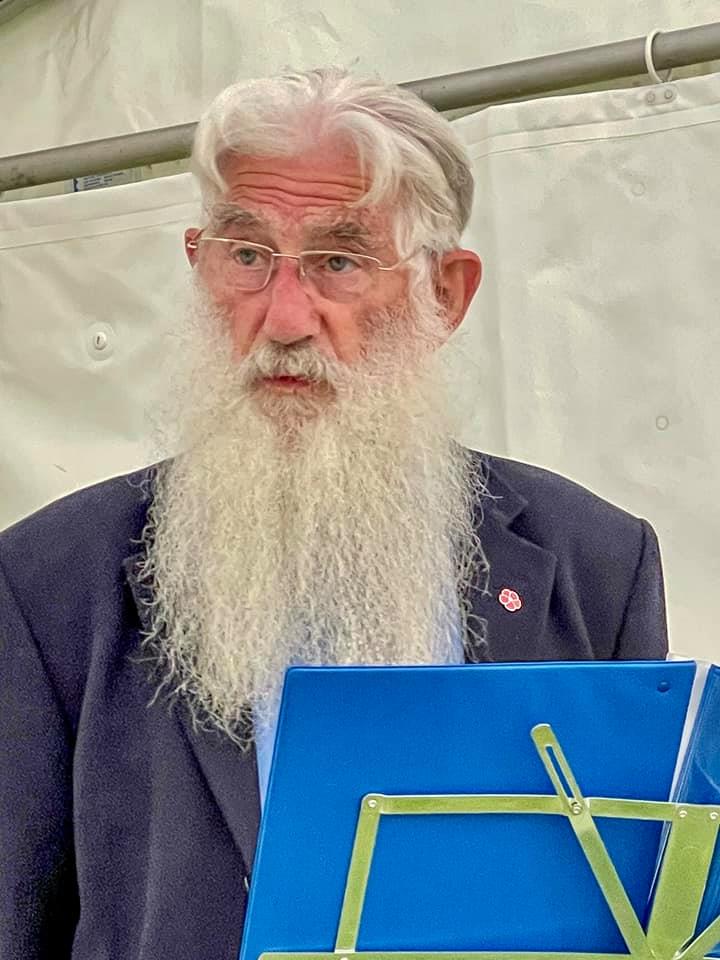
Our Dickens Library
Our Dickens Library is growing , with many thanks to Andrea Thompson from Mansfield , Nottinghamshire , who donated her collection of Dickens novels that she has owned for over 40 years for Haviland Cottage guests to read.
18th April 2022
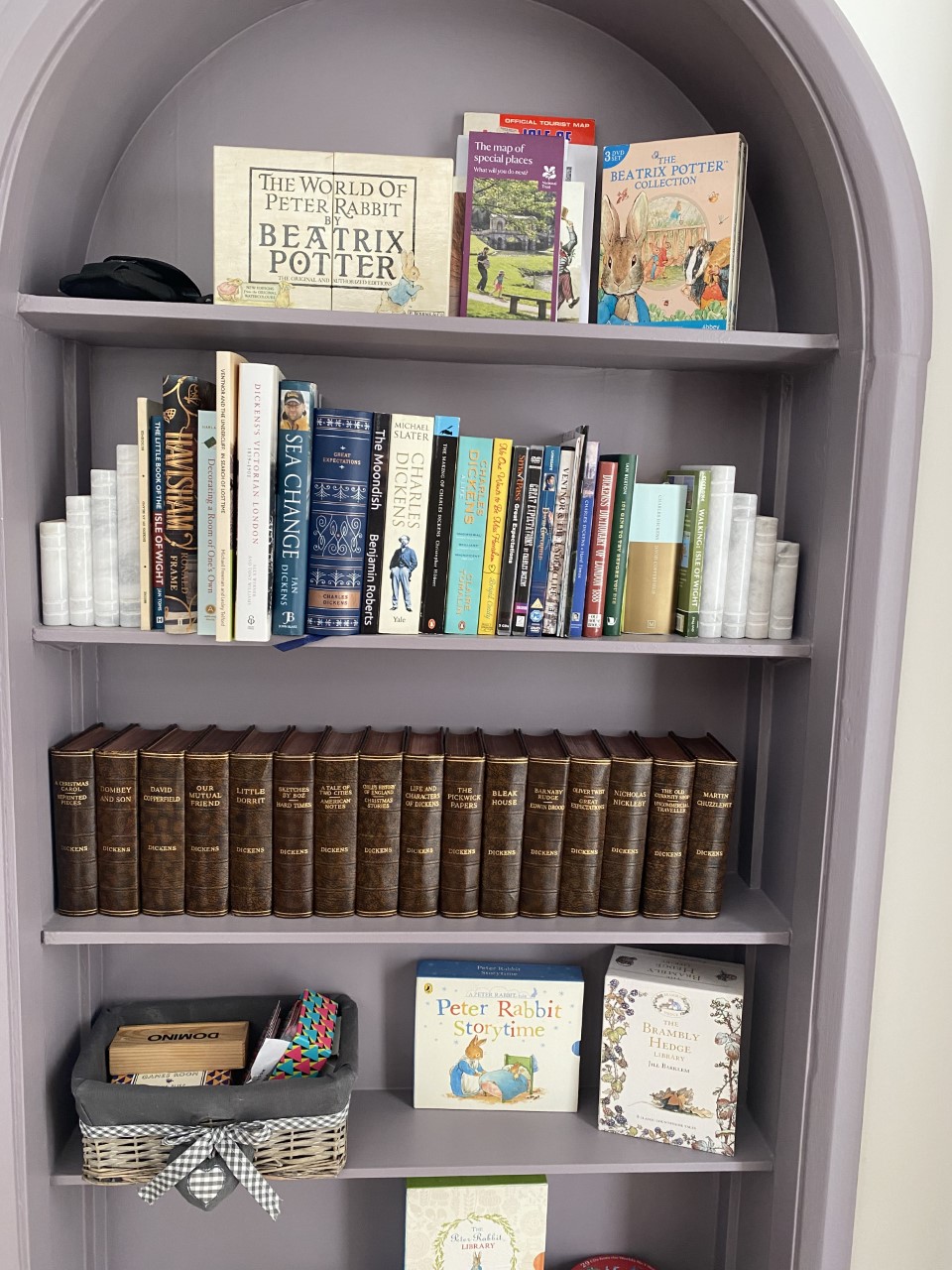
The famous TV Producer Jamie Langton on reading this blog decided to make a film about our discoveries. Thes short film, with high production values , features Ian Dickens ( Charles Dickens Great Great Grandson,) Sue Lowday ( Historian ) and Alan Cartwright.
Please click on the YouTubelink below to screen the film , and also please share with friends and family
Premiered on 24th September 2023
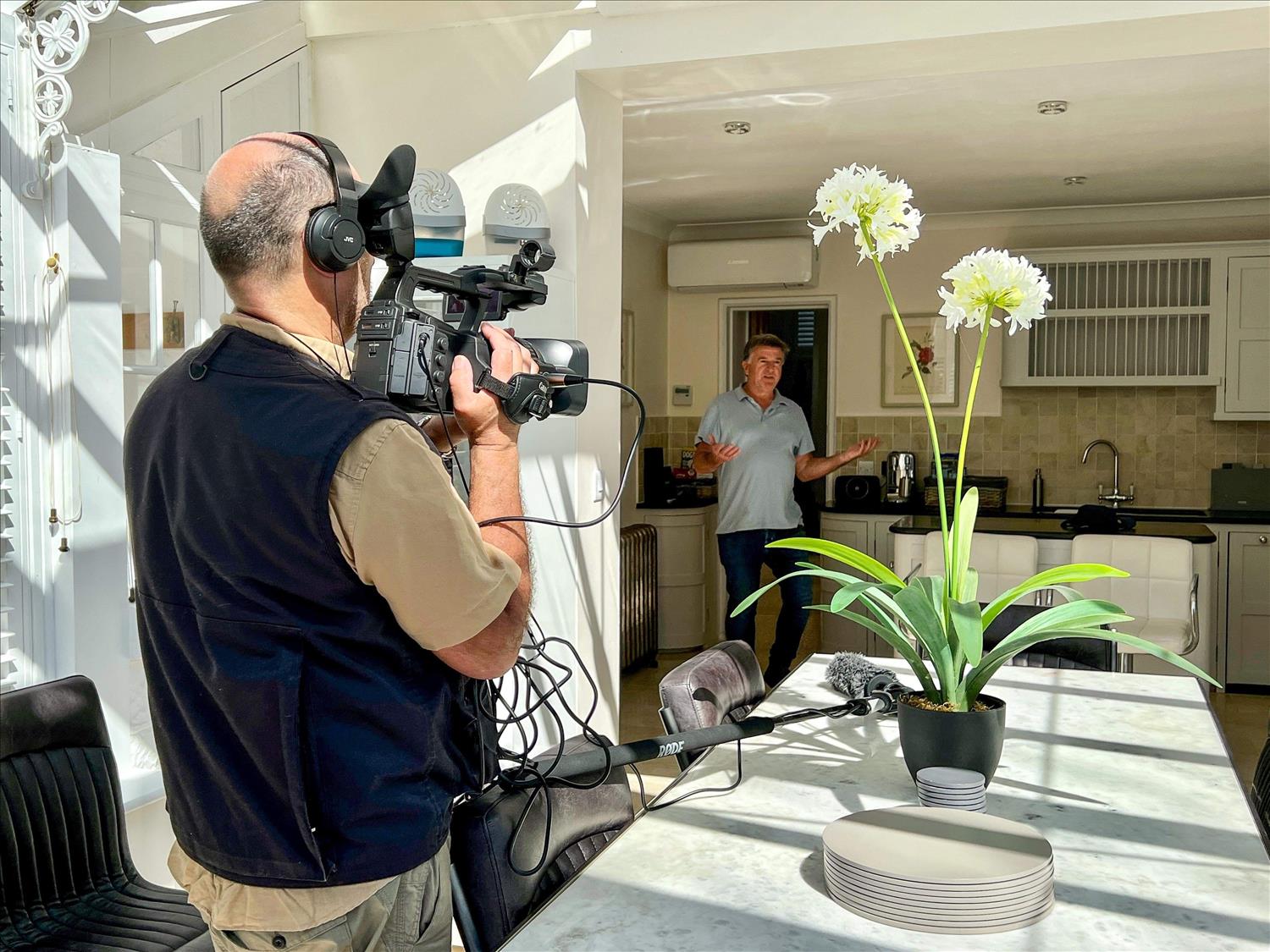
Recent Press Articles
Since this blog was published in March 2021 , our discoveries have appeared in over 50 newspaper articles around the world, here is a selection:
Jilted Isle Of Wight Bride ‘The Real Miss Havisham’ - Isle of Wight Radio (iwradio.co.uk)
The real-life inspiration for famous Dickens character has been found (thescottishsun.co.uk)
Has the real-life inspiration for Miss Havisham been uncovered? ‹ Literary Hub (lithub.com)
Blog | bonchurch (bonchurchvillage.co.uk)
Was a jilted Isle of Wight bride the real life Miss Havisham? (dailymail.co.uk)
Charles Dickens, Novelist, 37 Years old.
Captain Samuel Dick RN, Retired Naval Officer, 65 years old.
Charles George Dick, Son of Samuel Dick , 37 years old.
Margaret Catherine Dick, Daughter of Samuel Dick, 22 years old.
Catherine Fane Haviland, Gentle-Women , 32 years old.
Rev James White, Property Developer and Author, 40 years old.
Algernon Swinburne, Poet, 12 years old.
James Leech, Punch Illustrator, 32 Years old.
Alfred Tennyson, Poet, 40 years old.
William Makepeace Thackery, Novelist, 38 years old.
Thomas Carlyle, Writer, 54 years old, writer of “The French Revolution” inspiring Dickens to write “Tale of Two Cities”.
Mark Lemon, Journalist / Actor, 40 years old, Founded Punch Magazine 8 years earlier.
Queen Victoria, Monarch 30 years old, residing at Osborne House (East Cowes).
Queen Adelaide, 59 Years Old, Aunt to Queen Victoria, Wife of the late King William IV, Summer house of Westfield (although ill in London at the time). Adelaide in South Australia named after her.
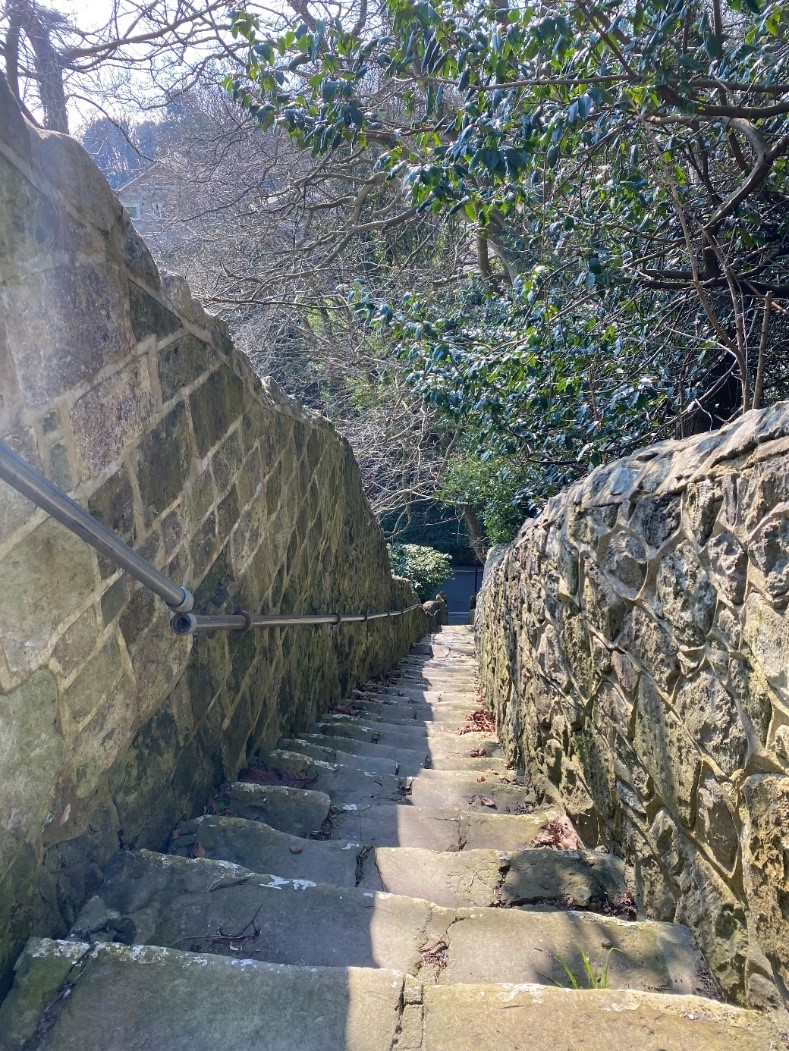
[1]The Pilgrim Edition of the Letters of
Charles Dickens, Vol. 1: 1820–1839 p433
Oh Mr. Groves
If so be you approves
Of writings in rhyme
Knocked off in quick time
And set down at once
By an indolent dunce
Who to Alum bay runs—
Read these lines Mr. Groves.
Because I've a wife
And I swear on my life
It would our blushes bring
To have that sort of thing,—
So no stranger coves
If you please Mr. Groves.
And when people repair
Here, to dine in the air
Just give 'em their grub
On some barrel or tub
In the cow,yard or garden;—
I'll bet a brass farden
They'll eat as much cheese,
And cough spit and sneeze
For those same twenty heads
Who are coming for beds
From Cowes or from Ryde,
Or from some hole beside,
Don't fit up that "Tent"3
Which in our room is meant
For some very small child
Of years meek and mild,
And make as much shindy
As outside our windy;
So there put their loaves
If you please Mr. Groves
And as Ann is a maid
By no means afraid
Of doing what's right
By day or by night,
And perfectly able
To wait well at table,
If she's wrong here and there
Don't bluster and swear
But of slight faults absolve her.
Yours truly—
[2] Volume 5 Pilgrim Charles Dickens
a) TO JOHN FORSTER, [26 SEPTEMBER
1849]
Extract in F, vi, iii, 504. Date: 26
Sep according to Forster.
My plans are all unsettled by Leech's
illness; as of course I do not like to leave this place while I can be of any
service to him and his good little wife. But all visitors are gone to,day, and
Winterbourne once more left to the engaging family of the inimitable B. Ever
since I wrote to you Leech has been seriously worse, and again very heavily
bled. The night before last he was in such an alarming state of restlessness,
which nothing could relieve, that I proposed to Mrs. Leech to try magnetism.
Accordingly, in the middle of the night I fell to; and, after a very fatiguing
bout of it, put him to sleep for an hour and thirty,five minutes. A change came
on in the sleep, and he is decidedly better. I talked to the astounded little
Mrs. Leech across him, when he was asleep, as if he had been a truss of hay. …
What do you think of my setting up in the magnetic line with a large brass
plate? "Terms, twenty,five guineas per nap."
TO MRS JOHN LEECH, [23] SEPTEMBER
1849
MS Benoliel Collection. Date:
misdated by CD;
Sunday (on which CD and Beard sat up
with Leech all night: To Forster, 24 Sep) was 23 Sep in 1849. Address: Mrs.
Leech.
Winterbourne, Sunday Night | Twenty
Seventh September 1849.
My Dear Mrs. Leech.
I cannot help thinking that it would
be better—and that it would be more comfortable for you—if Beard and I came and
sat upon the little sofa in the sitting room1 until Morning. I wish you would
think with me, and say Yes. The probability is that Leech will fall into a
sleep, and get infinitely better, but I don't like to think of you alone
there,—and it would be an immense relief to me to be your friend at hand, as I
ever am at heart. Let me beg you to think of this again—not for any need's sake
(thank God) but for your own greater ease, and ours.
Ever Affectionately Yours
John waits for a word.
[3] Volume 5 Pilgrim Charles Dickens
Letter to his Accountants
TO F. M. EVANS, 19 JULY 1849*
MS Dickens House.
Devonshire Terrace | Nineteenth July
1849.
My Dear Evans.
I want a hundred pounds to be paid
into Coutts's, if you can achieve that performance. If convenient, I shall be
much obliged to you to do this at once.
I enclose a few heads for Mr. Joyce,
2 concerning a weekly visit he will receive, during my absence from town, from
Topping.
My address, from Monday until the end
of September, will be
Winterbourne Villa
Bonchurch
Isle of Wight.
If you should ever feel inclined (as
I think you will) to run away on a holiday, and will come to the aforesaid
address, you shall receive a very hearty welcome, and see a very beautiful
place. "A favorable opportunity now offers", as Mr. Pecksniff used to
say in his advertisements, 1 and I hope you'll not neglect it.
I don't know what the Devil is the
matter with your people, in connexion with my Manuscript, but nothing between
folio 10 and folio 24 of the last No. is returned. Will you get the missing portion
for me, and relieve my mind by blowing up somebody?
I think this is all I have to say at
present.
Faithfully Ever
Charles Dickens
Have you heard from Bradbury?
[4] ]Bonchurch Booklet written by Peter Brett
published by the Bonchurch Parochial Church Council.
“Dickens had picnics on the downs and at
Blackgang attended tea,parties with the Swinburne’s at East Dene, dined at “parson
Fielden’s” and was entertained by Captain Samuel Dick RN at Uppermount (now
Peacock Vane). At Winterbourne he entertained many of his literary friends
including Thackeray, Carlyle, Tennyson and Mark Lemon.”
[5] Dickens on an Island – Richard Hutchings 1976
[6]Dickens Letter to Elizabeth Sewell in late 1859,60- Extract from the ‘dying’ letter:
“My "two young ladies" are
at Bonchurch on the sad mission of cheering a dying young friend. When they
come back, I shall propound to them the idea of their trying their influence
with Mrs. Brookfield to induce her and you to come and see us here.”
Note ,The Mrs Sewell is thought to be
Elizabeth Missing Sewell (1815–1906), High Church writer for children, whom
Charles Dickens had met once at Bonchurch.
[7]Where was Dickens? – Philip Currah ( Page 37)
[8] Royal Hotel History by Georgia Wyatt,Willsmore
– April 2016.
[9} The Fashionable List was a list of gentry who were either resident or were visiting the area
[10] The Hampshire Advertiser , Ventnor January 16th 1869
"VISIT OF THE QUEEN TO ASHLEIGH. - On Saturday afternoon Her Majesty , accompanied by their Royal Highnesses Prince Leopold and Princess Beatrice, and attended by Lady Churchill , honoured Lord and Lady Alfred Paget with a visit at Ashleigh, Bonchurch. Colonel Ponsonby was in attendance as Equerry in Waiting. The Royal carraige, which was open entered Ventnor by way of the Serpentine road , and passed through the town, Her Majesty graciously acknowledging the expressions of loyalty by frequently bowing along the route. On leaving Ashleigh, where a considerable number of visitors and inhabitants had congregated , Her Majesty , in acknowledgement of the hearty cheers given by those assembled bowed and smiled."
[11] The Project Gutenburg EBook of The Life of Charles Dickens , Vol . 1-111 ( #425)